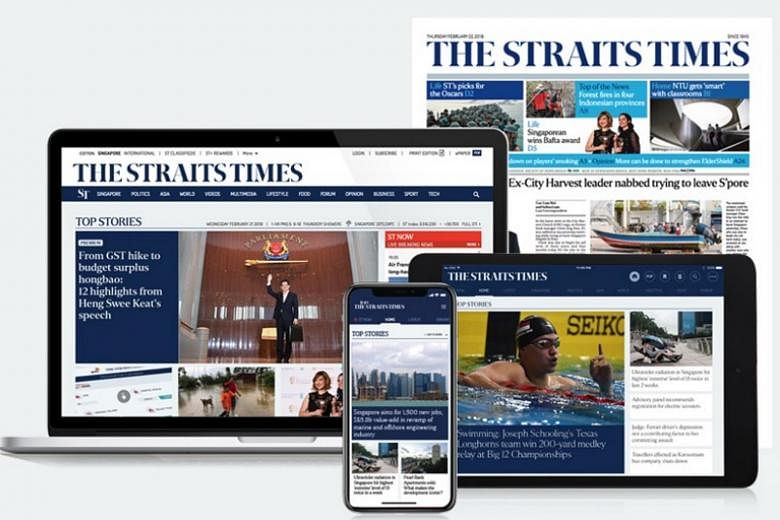SINGAPORE - More Singapore residents are reading local newspapers online, but the increase has not been able to offset the decline in print readership, leading to a slide in overall newspaper consumption this year.
The Straits Times, however, bucked the trend, growing its overall readership and retaining its top spot as the most-read local English title with the increase in digital readership outstripping the dip in print, according to the 2018 Singapore Media Index Report released by Nielsen on Wednesday (Nov 7).
Singapore Press Holdings' (SPH) flagship daily saw its digital-only readership grow from about 413,000 to 597,000 over the last year, making it now nearly on a par with its print base, which dipped from 713,000 to 600,000.
The number of readers that read both print and digital versions dropped from 212,000 to 187,000. The figures include The Sunday Times readership.
ST has a combined print and digital readership reach of 29.8 per cent on an average daily basis, according to the survey of 4,688 people aged 15 and above by the market survey company Nielsen.
Overall, the combined readership of local print and online newspapers was one in two adults between July 2017 and June 2018, while digital versions of local newspapers also reached one in five adults on an average daily basis.
Overall newspaper readership dropped 4 percentage points this year, with print registering a larger decline of 8.7 percentage points and digital growing 3.1 percentage points.
"Consumers are increasingly viewing local newspapers online, with digital readership of such publications registering growth," said Mr Yee Chong Moon, Nielsen Singapore's executive director for media.
"The strengthening of investments in producing high quality digital content by media owners, are catering to the evolving media habits of tech savvy consumers," he added.
SPH's other English-language papers, The New Paper and The Business Times, had an average daily readership of 5.5 per cent and 2.2 per cent respectively.
The New Paper had the highest proportion of readers aged 15 to 29 years old (28.5 per cent), while half of ST's readers and seven in 10 of those who read The Business Times were professionals, managers, executives and businessmen (PMEB).
Lianhe Zaobao remained the top Chinese-language paper, with a combined daily readership of 12.7 per cent among Chinese readers, followed by Shin Min Daily News (9.1 per cent) and Lianhe Wanbao (8 per cent).
Malay-language paper Berita Harian's daily combined readership was 3.2 per cent, while Tamil Murasu had 0.8 per cent. About a fifth of those surveyed visited ChannelNewsAsia's website on a weekly basis.
Mr Yee said local readers continue to give their "stamp of approval" to established local news providers as their trusted source of news content. According to Nielsen's Singapore Digital Consumer Study, adults accessed online news content mainly from news publishers (68.3 per cent), compared to other news sources (35.6 per cent).
Among Nielsen's other findings are that music streaming registered the highest growth among online activities, with close to two in five doing so, while four in five watched television, movies and videos and more than half of adults accessed news online on an average month.
Nielsen found that 96.6 per cent of magazine readers browse the hard copy, with Her World remaining the most popular title for women's monthly magazines.
Nine in 10 adults tune into the radio on a weekly basis, with Class 95 having the highest listenership (18.2 per cent) among English stations, followed by Kiss92 (13.6 per cent), 987 (12.6 per cent), Gold 90.5 (9.6 per cent) and One FM 91.3 (5.5 per cent). Love 972 came out on top among Chinese listeners.
When it comes to television, eight in 10 local viewers tune into free-to-air channels, with Chinese-language Channel 8 coming out on top with a weekly reach of 51.1 per cent.
Pay TV had a weekly viewership of 41.6 per cent. Nearly half of PMEBs and those with a monthly household income of $5,000 and above watched Pay TV programmes weekly.


